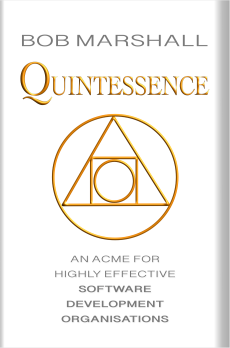Interactive Book: Quintessence
This page serves as the sidecar to the third book in my Organisational Psychotherapy series: “Quintessence”.
Quintesssence maps out in some 70+ chapters (see: Part II) the memes that drive highly effective collaborative knowledge work (CKW) organisations. And in particular, highly effective software companies. Each chapter a.k.a. meme in Quintessence describes one idea, topic, or meme found in the memeplex, or shared mindset, of such companies.
Interactive Book
By “interactive” I mean that through the ten prompts found in each chapter’s sidecar (see links to chapters, below) readers of “Quintessence“, having read a chapter, can explore the contents of the chapter / meme in more depth by copying one or more of the suggested prompts and pasting a promt into i.e. ChatGPT-4. The chatbot will then respond, using its huge knowledge base, with information on an aspect of the selected chapter.
How To Use this Interactive Book
From here you can jump to the page relating to one specific chapter of Quintessence (a.k.a. meme, or topic). Choose a chapter from the Table of Contents, below, and follow the link to a specific topic of interest. This may be the chapter you’re in the middle of reading, or have just read. Or it may be a chapter you wish to recap or explore further. Once on page the page for your chosen topic, choose a prompt, and submit your selected prompt or prompts, one at a time, to your chatbot. Use the prompts as provided, or feel free to rewrite them.
Learning Paths
A Learning Path consists of a series of exercises intended to help you master the content of the chapter. In addition to the ten main prompts, each chapter/topic page also provides a suggested learning path, and some prompts to generate alternative learning paths, in case the suggested path doesn’t quite meet your needs.
Quintessence: Table of Contents
- Foreword
- Acknowledgements
- Preface
Part I
Overview
- Introduction.
- About this Book
- Parts
- The Big Picture
- Definitions
- Ambition
- The Organisational Dimension
- Whole-organisation thinking
- Enrolling the Folks
- Pipe Dreams
Part II
The Quintessential Mindset
- Chapter 10. Change 59
- Chapter 11. Discussion 63
- Chapter 12. Undiscussables 65
- Chapter 13. Courage 67
- Chapter 14. Needs 69
- Chapter 15. Who Matters? 73
- Chapter 16. Collective Mindsets 77
- Chapter 17. Success 81
- Chapter 18. Culture 83
- Chapter 19. Structure 87
- Chapter 20. Coevolution 91
- Chapter 21. Talent 93
- Chapter 22. Relationships 95
- Chapter 23. Remuneration 99
- Chapter 24. Flow of Value 103
- Chapter 25. Waste 107
- Chapter 26. Purpose 111
- Chapter 27. Case For Action 115
- Chapter 28. Vision 117
- Chapter 29. Effectiveness 119
- Chapter 30. Efficiency 123
- Chapter 31. The Role of “The System” 127
- Chapter 32. Part / Whole Thinking 131
- Chapter 33. Innovation 133
- Chapter 34. Variability 137
- Chapter 35. Learning 141
- Chapter 36. The Nature of Work 145
- Chapter 37. The Way the Work Works 149
- Chapter 38. Improvement 153
- Chapter 39. Play 157
- Chapter 40. Utilisation 161
- Chapter 41. Doctrine 165
- Chapter 42. Quality 167
- Chapter 43. ZeeDee 171
- Chapter 44. Cost of Focus 173
- Chapter 45. Cost of Delay 175
- Chapter 46. Risk 177
- Chapter 47. Quantification 183
- Chapter 48. Metrics and Measures 185
- Chapter 49. Hierarchy 187
- Chapter 50. Management 189
- Chapter 51. Single Wringable Neck 191
- Chapter 52. Ownership and Control 193
- Chapter 53. Teams 195
- Chapter 54. Silos or Value Streams 199
- Chapter 55. Projects, Products or Other 201
- Chapter 56. Time Horizons 205
- Chapter 57. Speed 207
- Chapter 58. Homogeneity 209
- Chapter 59. Reuse 213
- Chapter 60. Software or Not 215
- Chapter 61. Cadence 217
- Chapter 62. Decision-making 219
- Chapter 63. Evidence 223
- Chapter 64. Transparency 225
- Chapter 65. Technical Competencies 227
- Chapter 66. Mudballs 229
- Chapter 67. Financials 231
- Chapter 68. Governance 233
- Chapter 69. Workplaces 237
- Chapter 70. OrgCogDiss 241
- Chapter 71. Violence 243
- Chapter 72. Nonviolence 245
- Chapter 73. Engineering 247
- Chapter 74. Powerpoint and Slide Decks 251
- Chapter 75. HR 253
- Chapter 76. Recruiting 255
- Chapter 77. Batch Size 259
- Chapter 78. Theory of Constraints 261
- Chapter 79. Beliefs About People 265
- Chapter 80. Morale 269
- Chapter 81. Motivation 273
- Chapter 82. Engagement 277
- Chapter 83. Psychological Safety 279
- Chapter 84. Giants 281
- Chapter 85. Meetings 283
- Chapter 86. Complexity 287
- Chapter 87. Status 291
- Chapter 88. Conflict 293
Part III
Appendices
- Appendix A – Javelin
- Appendix B – Javelin Articles of Understanding
- Endnotes
- About the Author
- Colophon

